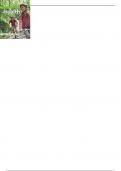, TABLE OF CONTENTS
Chapter 1 An Invitation to Health and Wellness......................................................1-1
Chapter 2 Psychosocial Health................................................................................2-1
Chapter 3 Personal Stress Management...................................................................3-1
Chapter 4 Physical Activity for Fitness, Health, and Athletic Performance............4-1
Chapter 5 Personal Nutrition...................................................................................5-1
Chapter 6 Healthy Eating for Weight Management.................................................6-1
Chapter 7 Personal Relationships and Sexuality.....................................................7-1
Chapter 8 Birth Control Choices and Pregnancy.....................................................8-1
Chapter 9 Protecting Yourself from Infectious Diseases.........................................9-1
Chapter 10 Lowering Your Risk of Major Diseases..................................................10-1
Chapter 11 Drug Use, Misuse, and Abuse.................................................................11-1
Chapter 12 Alcohol and Tobacco Use, Misuse, and Abuse.......................................12-1
Chapter 13 Traditional and Complementary Health-Care Approaches.....................13-1
Chapter 14 Staying Safe: Preventing Injury, Violence, and Victimization................14-1
Chapter 15 Healthy Aging.........................................................................................15-1
Chapter 16 Working Toward a Healthy Environment................................................16-1
Chapter 17 The Spirit of Health and Wellness...........................................................17-1
,Chapter 1—An Invitation to Health and Wellness
MULTIPLE CHOICE
1. Which of the following have an interconnectedness, according to Aboriginal health, as guided
by holism?
a. the mind and the spiritual world
b. the body, mind, and spirit
c. the individual and health care
d. the individual and the spiritual world
ANS: B PTS: 1 DIF: 2 REF: 4
BLM: Remember
2. According to the First Nations Medicine Wheel, which four aspects of our lives should be in
balance?
a. physical, intellectual, emotional, social
b. psychological, mental, religious, social
c. psychological, mental, emotional, religious
d. physical, mental, emotional, spiritual
ANS: D PTS: 1 DIF: 2 REF: 4
BLM: Remember
3. How does the World Health Organization define health?
a. physical health accompanied by sound mental health
b. a state of complete physical, mental, and social well-being
c. having regular medical checkups
d. being sound in body, mind, and spirit
ANS: B PTS: 1 DIF: 2 REF: 4
BLM: Remember
4. Which group of four elements is included in the Health Field Concept framework?
a. health-care organizations, lifestyle, environment, human biology
b. lifestyle, health-care organizations, human biology, illness prevention
c. health promotion, human biology, lifestyle, health-care organizations
d. human biology, environment, health-care organizations, health promotion
ANS: A PTS: 1 DIF: 2 REF: 5
BLM: Remember
5. Which term is defined as the process of enabling people to increase control over their health
and improve it?
a. wellness
, b. intellectual health
c. holistic health
d. health promotion
ANS: D PTS: 1 DIF: 2 REF: 5
BLM: Remember
6. Which three national health challenges were identified in the 1986 report titled Achieving
Health for All: A Framework for Health Promotion?
a. reducing inequities, increasing prevention effort, enhancing people’s capacity to
cope
b. increasing prevention effort, reducing disease rates, reducing inequities
c. enhancing people’s capacity to cope, increasing prevention effort, reducing disease
rates
d. reducing disease rates, reducing inequities, enhancing people’s capacity to cope
ANS: A PTS: 1 DIF: 2 REF: 5
BLM: Remember
7. In the Achieving Health for All: A Framework for Health Promotion report, which three
mechanisms to health promotion were identified?
a. healthy eating, supportive care, supportive environment
b. healthy environments, supportive care, healthy eating
c. healthy environments, self-care, mutual aid
d. supportive environments, self-care, mutual aid
ANS: C PTS: 1 DIF: 2 REF: 5
BLM: Remember
8. Which three life domains were identified in the Quality of Life Model?
a. beginning, belonging, and becoming
b. being, belonging, and becoming
c. being, belonging, and togetherness
d. belonging, becoming, and togetherness
ANS: B PTS: 1 DIF: 2 REF: 5-7
BLM: Remember
9. What does the term “population health” refer to?
a. predisposing factors concerning health in the Canadian population
b. population density and its impact on the health of Canadians
c. the accessibility of health care for Canadians
d. the social and economic forces that shape the health of Canadians
ANS: D PTS: 1 DIF: 2 REF: 5





